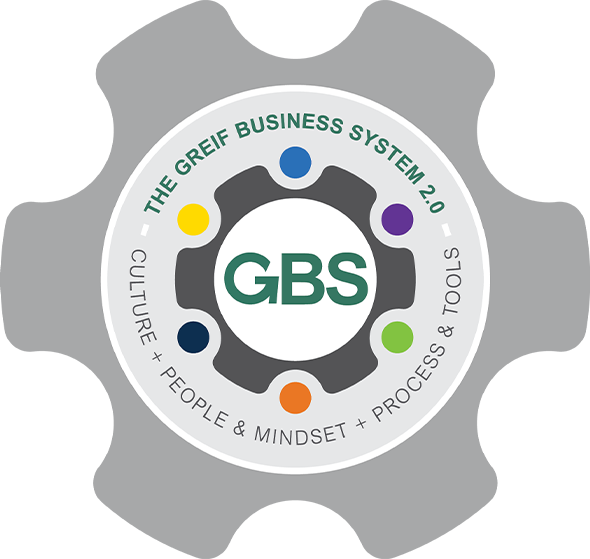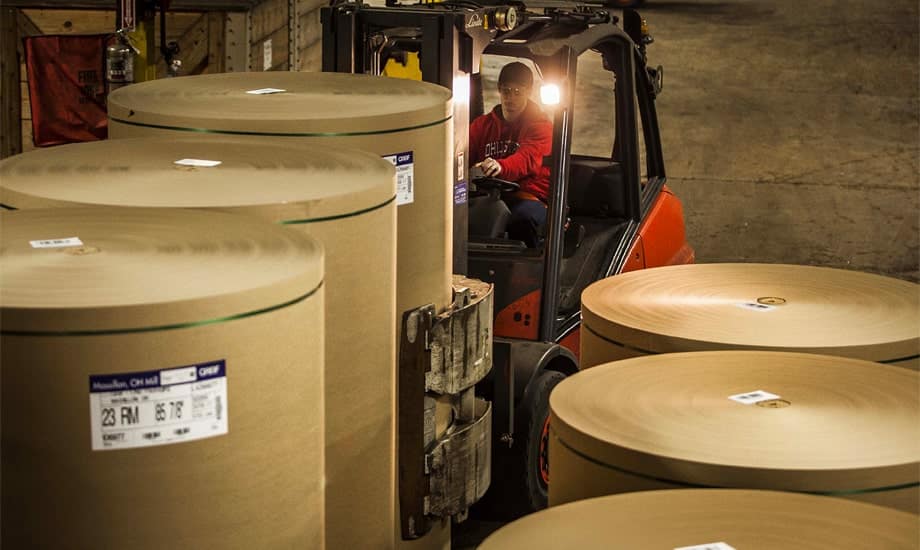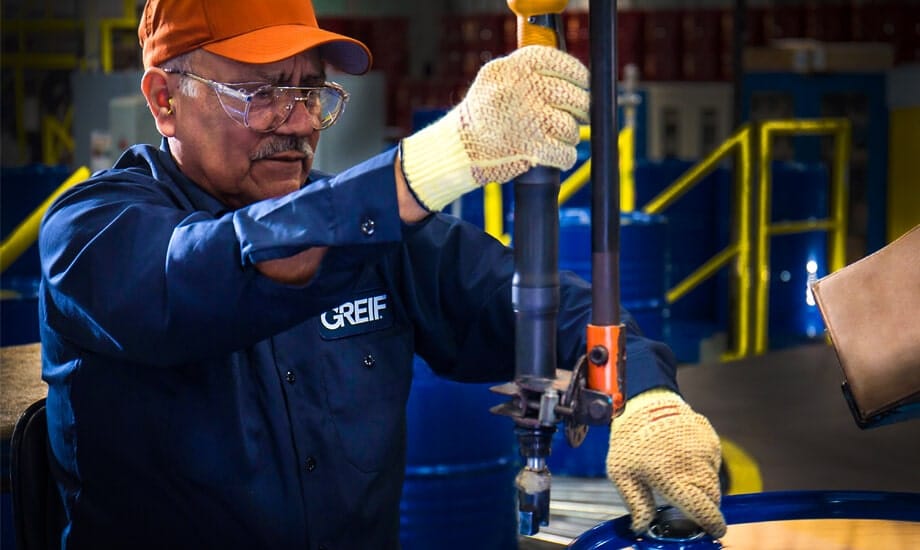Points forts
- En 2022, nous avons créé le Global Operations Group, un groupe mondial de dirigeants dont l’objectif est de nous permettre d’aligner notre stratégie et nos objectifs en matière de qualité des produits à l’échelle mondiale et de normaliser les approches auparavant gérées au niveau régional.
- Greif Business System 2.0 étend notre capacité à exercer des points de contrôle critiques dans le processus de fabrication pour découvrir et corriger les écarts par rapport aux spécifications de production avant qu'un défaut potentiel n'atteigne un client ou n'affecte la production.
- Les feuilles de route stratégiques de qualité aident à identifier les initiatives de qualité des produits grâce à un processus standardisé et s'alignent sur les objectifs stratégiques de Greif et nos objectifs 2030 tout en soutenant l'amélioration continue.
- En 2022, nous avons atteint un taux global d’actions correctives de 0,43 et un taux global de fuite zéro de 0,11.
Pourquoi la qualité des produits est importante
La qualité des produits est essentielle à notre activité et à notre mission : offrir un service client exceptionnel. Ne pas répondre aux besoins de nos clients avec les normes les plus strictes compromet nos valeurs fondamentales et entrave notre objectif de devenir l'entreprise de service client la plus performante au monde. Nos clients comptent sur notre engagement qualité pour garantir la protection et la sécurité de leurs produits, tant pour les personnes que pour l'environnement. La qualité des produits est essentielle à la conformité réglementaire et à la réussite financière. Ces enjeux et ces attentes élevés nous poussent à améliorer continuellement la qualité de nos produits, en nous efforçant d'obtenir des produits de la plus haute qualité et sans défaut dans tous nos sites de production.
Gouvernance
En 2022, nous avons créé le Groupe des Opérations Mondiales (GOG), dirigé par le Vice-Président Senior des Opérations Mondiales, qui siège au sein de l'Équipe de Direction Exécutive (ELT). Le GOG est un département fonctionnel composé de deux niveaux régionaux : Amérique du Nord et Amérique Latine (AMER) et Europe et Moyen-Orient, Afrique et Asie-Pacifique (EMEA/APAC), qui soutient toutes les unités opérationnelles. Cette structure nous permet d'aligner notre stratégie et nos objectifs en matière de qualité produit à l'échelle mondiale tout en standardisant notre approche. Ce groupe permet également à différentes équipes, telles que les Solutions Produits Mondiales et l'Amélioration Continue, de travailler de manière transversale et de coordonner leurs efforts pour atteindre les objectifs de qualité.
Notre objectif est de créer une approche standardisée et globale pour offrir un service client légendaire grâce à notre système de gestion de la qualité. politique mondiale de qualité des produits Établit des normes et une approche uniforme en matière de qualité des produits. Notre équipe Qualité des produits s'efforce d'identifier et de mettre en œuvre les meilleures pratiques de gestion de la qualité des produits. En 2020, nous avons lancé notre programme Sécurité/Qualité basé sur l'engagement (SCE/Q) et dispensé à tous les superviseurs et managers une formation en leadership afin de faciliter le programme SCE/Q et de promouvoir une culture de la sécurité et une plus grande responsabilisation. En 2022, nous avons formé les dirigeants jusqu'au troisième niveau de management dans le cadre de ce déploiement, instaurant ainsi un dialogue quotidien sur la qualité et la sécurité des produits. Nous poursuivrons la formation des dirigeants au fur et à mesure de l'avancement du programme. Pour en savoir plus sur ce programme, consultez le rapport de ce programme. Santé et sécurité section.
En 2022, nous avons adopté l'Engagement de la Direction Générale dans le cadre de notre Programme de Gestion de la Qualité. Cet engagement porte sur la collaboration de Greif avec ses parties prenantes et le maintien de sa conformité réglementaire. Greif Business System 2.0 (GBS 2.0) viendra appuyer cet engagement. GBS 2.0 renforce notre capacité à détecter et corriger les écarts par rapport aux spécifications de production avant qu'un défaut potentiel ne survienne. Nous signalons les problèmes de qualité potentiels via notre système de planification des ressources de l'entreprise (ERP) et, lorsqu'un problème de qualité est identifié, les procédures correctives sont documentées et communiquées via les canaux de communication appropriés. Nous continuons d'utiliser notre tableau de bord du Système de Gestion de la Qualité (SMQ) pour évaluer les performances des applications GBS 2.0. Ce tableau de bord génère un rapport sur la santé de l'organisation, incluant les réclamations clients, les actions correctives internes, les revues de direction et les évaluations des fournisseurs. Le Comité directeur mondial de la réglementation examine les demandes de nouvelles applications afin de déterminer et de prioriser les améliorations en fonction du bénéfice le plus important pour la performance qualité globale des produits. Nous poursuivons l'intégration du système ERP avec GBS 2.0 au niveau des articles, permettant à tous les collaborateurs d'utiliser une seule plateforme métier. Cette intégration nous permettra de gérer les certifications des matières premières et de les lier plus efficacement aux produits finis. Cette mise à jour améliore la transparence des matières premières lors de leur conversion en produits finis.

Système d'entreprise Greif 2.0
Greif a récemment entamé sa migration de Greif Business System (GBS) 1.0 vers GBS 2.0. Comparables à une mise à jour logicielle, ces changements visent à garantir notre pertinence vis-à-vis de notre environnement externe et de notre communauté d'utilisateurs. Nos processus et outils subissent actuellement une série de changements qui se poursuivront, mais nous veillerons à ce que chaque élément de GBS 2.0 fonctionne en parfaite harmonie avec tous les autres. GBS 2.0 établit un ensemble de méthodes et d'approches uniformes en termes d'échelle, de forme et de taille, contribuant ainsi à la cohérence de l'ensemble de notre organisation. Parallèlement à la mise en œuvre de notre stratégie « Construire pour durer », nous poursuivrons le développement, la livraison et le déploiement de GBS 2.0.
Chaque article que nous fabriquons est évalué quant à sa qualité, en fonction de son intégrité et de sa conformité aux spécifications applicables. En 2022, 53 % des 188 produits de Greif[1] les sites de production mondiaux éligibles étaient certifiée selon les normes ISO 9001 Pour la gestion de la qualité, nous intégrons 93 % de nos 107 sites de production d'emballages industriels mondiaux (GIP). Nous utilisons le suivi des réclamations clients et le taux d'actions correctives (CAR) pour maintenir un standard centralisé pour nos produits. Nous informons mensuellement nos présidents régionaux, vice-présidents et directeurs généraux de nos performances.
Nous utilisons notre système de qualité intégré, Greif QS, pour communiquer les normes de qualité à notre réseau de production. Greif QS abrite une suite d'applications qui garantissent la qualité et la cohérence de nos produits et processus dans toutes nos installations. Voici quelques exemples de ces applications :
- Systèmes de réponse aux plaintes et de mesures correctives
- Systèmes internes d'actions correctives et préventives
- Système de gestion des audits
- Systèmes d'étalonnage
- Systèmes de gestion des fournisseurs Système d'examen de gestion
- Systèmes de gestion des documents et de la formation
En 2021, nous avons ajusté nos indicateurs clés de performance (KPI), notamment en surveillant chaque mois le nombre de fuites et le taux de CAR pour fuites. Nous avons également mis en place un système d'alerte qualité qui envoie une alerte globale en cas de réclamation ou de mode de défaillance, notre processus de second approbateur qui permet au système de reconnaître les réclamations d'une certaine gravité, notre guide de dépannage qui évalue le mode de défaillance et le défaut représentatif et fournit les causes profondes possibles, ainsi que les inspections critiques automatisées qui impactent l'intégrité des produits. De plus, en 2021, nous avons commencé à piloter et à renforcer notre Système de Qualité Visuelle (SVQ) via notre axe de travail « Retour aux fondamentaux ». Depuis ce pilote, nous avons lancé la Formation 101 Type, une formation fondamentale à la fabrication de produits qui établit des normes de qualité visuelle aux postes de travail critiques, en coordination avec notre SVQ, dans deux sites sélectionnés.
L'outil de gestion du changement intégré au système de qualité Greif identifie et catégorise les modifications apportées aux matières premières, aux fournisseurs, aux processus et à d'autres indicateurs susceptibles d'avoir un impact sur la qualité et la sécurité des produits. Ce système utilise une série de questions pour déterminer la gravité du changement et lance un processus d'analyse avant son approbation. Une fois approuvé, le changement est communiqué aux fonctions concernées au sein de Greif. Cet outil nous permet d'impliquer les différents services de l'organisation, de générer des tâches pour garantir la conformité et d'informer l'équipe commerciale, qui peut ainsi informer nos clients des changements dans les meilleurs délais. Nous avons également intégré notre processus de certification ONU au système de qualité Greif, définissant les spécifications requises pour obtenir la certification ONU pour les produits concernés et gérant le processus de fabrication afin de garantir notre conformité. Outre les certifications ONU, nous respectons les normes REACH et incluons les déclarations de conformité REACH sur les fiches de données de sécurité (FDS), le cas échéant.
Améliorer notre programme de sécurité alimentaire est un engagement durable. En 2020, une analyse de marché a été réalisée sur les exigences et pratiques en matière de sécurité alimentaire, notamment en matière d'hygiène, de lutte antiparasitaire et de traçabilité, afin d'établir un programme de référence de bonnes pratiques de fabrication (BPF). Sur la base de ces exigences, nous avons développé un nouveau système ISO/BPF, intégrant nos exigences de sécurité alimentaire à nos processus de fabrication actuels dans l'ensemble de l'entreprise. 100 % des installations de GIP Amérique du Nord sont conformes aux nouvelles normes. Nous augmentons le nombre de nos installations de fabrication grâce à la certification Safe Quality Food (SQF) délivrée par le SQF Institute, un programme rigoureux et fiable de sécurité et de qualité alimentaires. Nous nous tenons informés de toutes les nouvelles législations alimentaires et des révisions concernant les emballages et exigeons de nos fournisseurs d'emballages destinés au contact alimentaire qu'ils se conforment aux réglementations locales.
Dans le cadre du GOG, nous continuons de réévaluer et d'exécuter nos feuilles de route stratégiques en matière de qualité. Ces feuilles de route garantissent que les initiatives en matière de qualité des produits sont identifiées selon un processus standardisé, qu'elles sont alignées sur les objectifs stratégiques de Greif et nos nouveaux objectifs de développement durable à l'horizon 2030, et qu'elles favorisent l'amélioration continue. La direction du GOG révise ces feuilles de route chaque année et fournit un plan triennal pour les initiatives prioritaires, ainsi que des plans de projet détaillés pour les initiatives à court terme. Les résultats de ces initiatives sont pris en compte dans les objectifs de performance individuels et collectifs et contribuent à l'amélioration du taux de satisfaction client (RCA), des réclamations clients et, in fine, de l'indice de service client (CSI) et du score de recommandation net (NPS) de Greif.

Améliorer notre réactivité
En 2022, nous avons testé un outil de gestion des plaintes conçu autour des huit disciplines fondamentales de la résolution des causes profondes des problèmes. Nous prévoyons de le déployer à l'échelle mondiale en 2023, ce qui nous permettra d'attribuer un niveau de risque aux plaintes. À mesure que le niveau de risque augmente, nous développerons d'autres outils pour y répondre.
- Affecter et constituer l'équipe
- Définir et décrire les non-conformités
- Contenir les non-conformités
- Identifier et décrire la cause profonde
- Choisissez l'action corrective
- Mettre en œuvre
- Vérification
- Féliciter l'équipe
Notre Système d'Information Technique (SIT) gère les informations sur les matériaux et la sécurité des produits. Avant d'acheter de nouveaux produits, nos collaborateurs consultent les fiches de données de sécurité (FDS) et les bases de données chimiques afin de garantir la conformité aux réglementations internes et externes. Greif fournit également à ses clients des FDS, des conseils d'emballage et des informations sur les produits compatibles avec nos emballages afin de les aider à choisir un emballage responsable. Nous utilisons des tests et des recherches sur les matériaux pour nos processus de fabrication et suivons en permanence les évolutions sectorielles et réglementaires en matière de conformité et de sécurité des produits.
Au sein de l'activité Emballages et Services Papier (PPS), chaque site CorrChoice dispose de laboratoires d'essais complets permettant de réaliser des tests de performance approfondis et de collecter des données en temps réel afin de contrôler la qualité des produits et de garantir leur conformité à nos normes. Les matières premières sont testées pour garantir leur homogénéité, et les résultats sont partagés avec nos fournisseurs. Des performances constantes des matières premières garantissent un produit fini plus uniforme. Ces laboratoires nous permettent également de collaborer étroitement avec nos clients pour évaluer les combinaisons et les performances des matériaux afin de fournir les spécifications adaptées à leur utilisation finale au meilleur rapport qualité-prix. Nous exigeons que les techniciens d'essai de tous nos centres d'essais répondent aux exigences de certification. La standardisation des équipements permet d'uniformiser les méthodes et les procédures des centres d'essai.
Collectivement, nos efforts en matière de qualité des produits contribuent à notre amélioration continue des domaines prioritaires pour nos clients : fuites, livraison à temps, contaminants et qualité esthétique.
[1] Au 31 octobre 2022.
Objectifs, progrès et performances
- Taux de mesures correctives : réclamations clients pour 100 000 unités produites
TAUX D'ACTION CORRECTIVE
Gestion de la qualité en temps réel
Les installations CorrChoice de Greif, qui font partie de notre activité Paper Packaging & Services (PPS), ont mis en place un ensemble d'outils qui nous permettent de surveiller et de corriger les problèmes de qualité potentiels en temps réel. Les outils établissent des alertes pour divers facteurs susceptibles d'avoir un impact sur la qualité, tels que la température et la capacité de stockage des matériaux, et corrigent les écarts avant qu'ils ne soient hors spécifications. Cette capacité nous permet de réduire les déchets, de suivre les écarts potentiels récurrents et d'éviter les longues séries de produits qui ne répondraient pas aux attentes des clients. Dans le cadre de notre système zéro défaut, nos lignes de production sont équipées de capteurs à ultrasons capables de détecter toute séparation ou variation pouvant survenir au cours du processus de fabrication, comme les différences d'espacement des étriers et de grammage du papier. Le système suit les défauts au fur et à mesure qu'ils descendent dans la ligne de production, en éliminant les produits défectueux et en recyclant les déchets.

Groupe de travail sur la qualité
En 2014, nos données CAR indiquaient que les fuites étaient la plainte la plus courante des clients en matière de qualité. En réponse, nous avons lancé un programme Zero-Leak pour éliminer les fuites de nos produits. Lorsqu'une plainte pour fuite était reçue, elle était transmise au vice-président régional et au directeur général et notre équipe d'ingénierie était chargée d'élaborer une solution concrète au problème et de la diffuser dans toutes les installations. Notre concentration sur la réduction des fuites a conduit à une réduction de 67 % des plaintes pour fuites entre 2014 et 2018, ainsi qu'à des améliorations significatives du nombre de fuites dans notre activité Tri-Sure.
En 2020, nous avons lancé un nouveau groupe de travail mondial sur la qualité, dont le but était d'examiner les problèmes les plus importants de nos clients en matière de qualité des produits. Notre objectif était d'analyser les facteurs externes et internes afin de déterminer les tendances communes. Grâce à cela, nous avons déterminé que nos plus gros problèmes internes étaient également corrélés à nos plus gros problèmes externes. Le plus gros problème des clients reste l'intégrité des produits. Le groupe a élaboré divers plans d'action visant à résoudre ces problèmes internes dans le but ultime de réduire les plus gros problèmes de nos clients. De nouvelles mesures ont été créées pour suivre l'avancement de ces initiatives.




